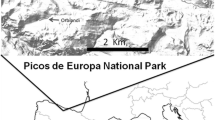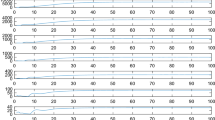Abstract
We present a matrix model for the study of the population dynamics of brown trout Salmo trutta L., introduced in the '60s in the virgin aquatic ecosystems of the Kerguelen Islands. This species clearly acclimatized very well: a portion of the population became migratory and spent a part of its life cycle in the sea, which allowed the rapid colonization of two rivers close to the stream of origin in the same bay (Baie Norvégienne).
These migratory trout can become a smolt at 2, 3, or 4 years of age. The model takes into account age and smolt age structures and in a first step considers the fish from the Baie Norvégienne as belonging to a single population. The transition matrix looks like a 32 × 32 Leslie matrix in which some survival rates are not on the subdiagonal. They represent survival after the first sea migration and are particularly important for the dynamics of the whole population.
The estimate of demographic parameters was obtained from a data base containing information collected in the field since 1970. The model was calibrated on the population size estimate and the stock structure of the migratory trout in 1979. Population size was estimated by tagging-recapture and monitoring of the migratory trout in freshwater when they returned to overwinter or reproduce. Under the hypothesis of a constant survival rate for all ages and categories of fish, it was possible to determine relationships between the annual population growth rate and survival rates at first downstream migration, for which no direct estimate was available.
These constraints on the model induced paradoxical results. For instance, an increase in survival rate reduced migratory trout numbers in the first years of colonization. These data suggested that the average survival rate should be around 0.3 and not 0.5 as surmised in previous studies. However, the model systematically underestimated numbers of migratory trout during the first years of development. Thus, to improve the model it will be necessary to introduce survival rates varying with time. Another possible approach would be to consider the population as three subunits corresponding to the three colonized rivers of the Baie Norvégienne.
Similar content being viewed by others
REFERENCES
Beall, E. and P. Davaine (1988). Analyse scalimétrique de la truite de mer (Salmo trutta L.): formation des anneaux et critères d'identification chez les individus sédentaires et migrateurs d'une même population acclimatée aux îles Kerguelen (TAAF). Aquat. Living Resour. 1:3–16.
Beall, E., P. Davaine and D. Bazin (1992). Étude scalimétrique de la truite commune à Kerguelen, TAAF. Principales difficultés et validation. In: J.L. Baglinière, J. Castanet, F. Conand and F.J. Meunier, eds., Tissus Durs et Âge Individuel des Vertébrés. Colloque National, Bondy, France (4–6 mars 1991), Colloques et Séminaires ORSTOM-INRA: 199–210.
Browne, J. (1988). The use of Leslie matrices to assess the Salmon population of the river Corrib. In: D. Mills and D. Piggins, eds., Atlantic Salmon: Planning for the Future, Proc. 3th Int. Atlantic Salmon Symp., p. 275–300. London, Croom Helm.
Caswell, H. (1989). Matrix Population Models. Sunderland, MA, Sinauer.
Caswell, H., R.J. Naiman and R. Morin (1984). Evaluating the consequences of reproduction in complex life cycles. Aquaculture 43: 123–134.
Cohen, J.E., S.W. Christensen and C.P. Goodyear (1983). A stochastic age-structured population model of striped bass (Morone saxatilis) in the Potomac River. Canadian Journal of Fisheries and Aquatic Sciences 40: 2170–2183.
Davaine, P. and E. Beall (1982a). Introduction de Salmonidés dans les Terres Australes et Antarctiques Françaises. CNFRA 51: 289–300.
Davaine P. and E. Beall (1982b). Acclimatation de la truite commune, Salmo trutta L., en milieu subantarctique (Îles Kerguelen): Stratégie adaptative. CNFRA 51: 399–411.
Davaine P. and E. Beall (1997). Introduction de Salmonidés en milieu vierge (Iles Kerguelen, Subantarctique): enjeux, résultats, perspectives. Bull. Fr. Pêche Pisc. 344/345: 93–110.
De Angelis, D.L., L.J. Svoboda, S.W. Christensen and D.S. Vaughan (1980). Stability and return times of Leslie matrices with density-dependant survival: applications to fish populations. Ecological Modelling 8: 149–163.
Elliot, J.M. (1994). Quantitative Ecology of the Brown Trout. Oxford, Oxford University Press.
Guyomard, R., C. Greévisse, F.X. Oury and P. Davaine (1984). Evolution de la variabilité génétique inter et intra-populations de populations de Salmonidés issues de mêmes pools génétiques. Canadian Journal of Fisheries and Aquatic Sciences. 41: 1024–1029.
Horst, T.J. (1977). Use of the Leslie matrix for assessing environmental impact with an example for a fish population. Transactions of the American Fisheries Society 106: 253–257.
Jarry, M., M. Khaladi and J.P. Gouteux (1996a). A matrix model for studying tsetse fly populations. Ent. Exp. Applic. 78: 51–60.
Jarry M., J.P. Gouteux and M. Khaladi (1996b). Are tsetse fly populations close to equilibrium? Acta Biotheoretica 44: 317–333.
Lebreton, J.D. (1996). Demographic models for subdivided populations: the renewal equation approach. Theor. Pop. Biol. 49: 291–313.
Leslie, P.H. (1945). On the use of matrices in population mathematics. Biometrika 33: 183–212.
Leslie, P.H. (1948). Some further notes on the use of matrices in population mathematics. Biometrika 35: 213–245.
Levin, S.A. and C.P. Goodyear (1980). Analysis of an age-structured fishery model. Journal of Mathematical Biology 9: 245–274.
Sabaton C., L. Siegler, V. Gouraud, J.L. Baglinière and S. Manné (1996). Presentation and first application of a dynamic population model for brown trout (Salmo trutta) — Aid to river management. Proc. Ecohydraulique 2000, Québec: 531–542.
Thomas T., P. Davaine and E. Beall (1981). Dynamique de la migration et reproduction de la truite de mer Salmo trutta L., dans la rivière Norvégienne, îles Kerguelen, TAAF. CNFRA 47: 5–42.
Author information
Authors and Affiliations
Rights and permissions
About this article
Cite this article
Jarry, M., Davaine, P. & Beall, E. A Matrix Model to Study the Colonization by Brown Trout of a Virgin Ecosystem in the Kerguelen Islands. Acta Biotheor 46, 253–272 (1998). https://doi.org/10.1023/A:1001789211146
Issue Date:
DOI: https://doi.org/10.1023/A:1001789211146




